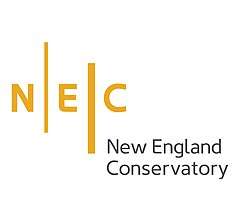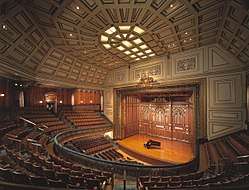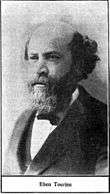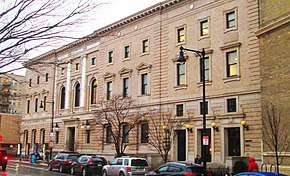New England Conservatory of Music
The New England Conservatory of Music (NEC) is a private music school in Boston, Massachusetts. It is the oldest independent music conservatory in the United States. The conservatory is located on Huntington Avenue of the Arts near Boston Symphony Hall and is home to 750 students pursuing undergraduate and graduate studies along with 1400 more in its Preparatory School as well as the School of Continuing Education. At the collegiate level, NEC offers the Bachelor of Music, Master of Music, and Doctor of Musical Arts, as well as the Undergraduate, Graduate, and Artist Diplomas. Also offered are five-year joint double-degree programs with Harvard University and Tufts University.[3]
 | |
| Type | Private music school |
|---|---|
| Established | 1867 |
| Endowment | $89.6 million[1] |
| Students | 750 |
| Location | , , United States |
| Campus | Urban |
| Website | necmusic |
New England Conservatory of Music | |
 Jordan Hall NEC's principal performance space | |
  | |
| Location | 290 Huntington Ave. Boston, Massachusetts |
| Coordinates | 42°20′26″N 71°5′13″W |
| Area | 1 acre (0.4 ha) |
| Built | 1903 |
| Architect | Wheelwright & Haven |
| Architectural style | Renaissance |
| NRHP reference No. | 80000672[2] |
| Added to NRHP | May 14, 1980 |
NEC is the only music school in the United States designated as a National Historic Landmark, and it is a pending Boston Landmark. Its primary concert hall, Jordan Hall, designed by Edmund M. Wheelright contains an organ modeled after the one at Santa Maria Della Scala in Siena[4] It hosts approximately 1,000 concerts each year.[5]
Early history

In June 1853, Eben Tourjée, at the time a nineteen-year-old music teacher from Providence, Rhode Island, made his first attempt to found a music conservatory in Boston, Massachusetts. He met with a group of Boston's most influential musical leaders to discuss a school based on the conservatories of Europe. The group included John Sullivan Dwight, an influential music critic, Dr. J. Baxter Upham, president of the Harvard Musical Association, and Oliver Ditson, a prominent music publisher. The group ultimately rejected Tourjée's plans, arguing that it was a poor idea to open a conservatory amidst the nation's political and economic uncertainty that would lead up to the American Civil War.
Tourjée made his next attempt in December 1866, when he again met with a group of Boston's top musicians and music patrons. Among Upham, Ditson, and Dwight at this meeting were Carl Zerrahn, a popular Boston conductor, and Charles Perkins, a prominent arts patron. In the thirteen-year interim, Tourjée had founded three music schools in Rhode Island, and this time was able to win over his audience. The men agreed to help Tourjée, and The New England Conservatory officially opened on February 18, 1867. It consisted of seven rooms rented above Music Hall off Tremont Street in downtown Boston. In 1870 it moved to the former St. James Hotel in Franklin Square in the South End.
Campus

The NEC campus consists of three buildings on both sides of Gainsborough Street, between St. Botolph Street and Huntington Avenue, one block from Symphony Hall. The Jordan Hall Building, whose main entrance is at 30 Gainsborough Street, is NEC's main building, home to Jordan Hall, Williams Hall, Brown Hall, the Keller Room, the Isabelle Firestone Audio Library, the Performance Library, professor studios/offices, and practice rooms. The second building, at 33 Gainsborough, is the Residence Hall, a coed dormitory which also houses the Harriet M. Spaulding Library and the "Bistro 33" dining center. The St. Botolph Building, at 241 St. Botolph street, contains Pierce Hall, a computer laboratory, the electronic music studio, and the majority of the school's classrooms and administrative offices.
Jordan Hall
Jordan Hall is NEC's central performing space. Opened in 1904,[6] Jordan Hall was the gift of New England Conservatory trustee Eben D. Jordan the 2nd, a member of the family that founded the Jordan Marsh retail stores and himself an amateur musician. In 1901, Jordan donated land for NEC's main building, while also offering to fund a concert hall with a gift of $120,000.
The dedication concert of Jordan Hall, performed by the Boston Symphony Orchestra, took place on October 20, 1903. Newspaper accounts deemed the hall "unequaled the world over," and The Boston Globe reported that it was "a place of entertainment that European musicians who were present that evening say excels in beauty anything of the kind they ever saw."[7]
A major renovation project was completed in 1995.
Academics
Admission to NEC is based primarily on a competitive live audition. The conservatory offers degrees in orchestral instruments, conducting, piano, jazz studies, contemporary improvisation, opera and voice (performance and pedagogy), composition, music history, and music theory.
The conservatory has served as a training ground for orchestral players to fill the ranks of the Boston Symphony Orchestra, much as the Curtis Institute serves as a training ground for the Philadelphia Orchestra, although composers, pianists, and singers are offered courses of study as well.
Preparatory School
New England Conservatory's Preparatory School is an open-enrollment institution for pre-college students. The preparatory school offers music classes and private instruction for young musicians, and fosters over 35 small and large ensembles. Students enrolled in the Preparatory School may participate in the Certificate Program, allowing students to achieve their optimum performance skills, competence in music theory, and a knowledge of the literature that includes choral, orchestral, and chamber music, as well as solo repertoire.
NEC Prep is home to the Youth Philharmonic Orchestra (YPO) as well as the NEC Youth Chorale. The Youth Philharmonic Orchestra headed by David Loebel is perhaps the most selective group at the school. The Preparatory School also houses the Massachusetts Youth Wind Ensemble (MYWE), a selective touring wind ensemble open to advanced high school woodwind, brass, and percussion players directed by Michael Mucci. The Preparatory Jazz program offers a Jazz Certificate that focuses on ensemble performance, the primary expression of jazz, supported by private lessons and a comprehensive group of courses covering jazz skills.
School of Continuing Education
NEC's School of Continuing Education offers classes in several fields including music history, music theory, and Alexander technique.
Partnerships
The conservatory offers five-year joint double-degree programs with Harvard University and Tufts University and cross-registration with Tufts, Northeastern University, and Simmons College.[8]
NEC is the founding institution of Phi Mu Alpha Sinfonia fraternity and Kappa Gamma Psi performing arts fraternity.
People
- See New England Conservatory alumni for a list of members of the alumni community.
- See New England Conservatory past and present teachers for notable members of the faculty.
Nomenclature
Although the institution is properly known as New England Conservatory, both the National Historic Landmark and the National Register of Historic Places nominations call out "New England Conservatory of Music" as the name of the historic designation.[2][9] Also, despite the statement on the subject's web site,[10] there is only one listing for each program, which covers the whole main building, including Jordan Hall, and no separate listing for Jordan Hall.[11]
See also
- Amy Beach (President, Board of Councillors)
- List of National Historic Landmarks in Boston
- National Register of Historic Places listings in southern Boston, Massachusetts
References
- As of June 30, 2009. "U.S. and Canadian Institutions Listed by Fiscal Year 2009 Endowment Market Value and Percentage Change in Endowment Market Value from FY 2008 to FY 2009" (PDF). 2009 NACUBO-Commonfund Study of Endowments. National Association of College and University Business Officers. Archived from the original (PDF) on December 14, 2017. Retrieved March 4, 2010.
- "National Register Information System". National Register of Historic Places. National Park Service. July 9, 2010.
- "Programs of Study". New England Conservatory. Archived from the original on February 20, 2010. Retrieved March 4, 2010.
- American Architect and Architecture. American Architect. 1903.
- "New England Conservatory of Music" (PDF). National Park Service – National Historic Landmarks Program. Retrieved April 9, 2015.
- Southworth, Susan & Southworth, Michael (2008). AIA Guide to Boston (3rd ed.). Guilford, Connecticut: Globe Pequot Press. pp. 230–231. ISBN 978-0-7627-4337-7.
- "Jordan Hall History". Handel and Haydn Society. Archived from the original on September 13, 2010. Retrieved March 4, 2010.
- "Course Offerings". New England Conservatory. Archived from the original on February 20, 2010. Retrieved March 4, 2010.
- "National Historic Landmark nomination for New England Conservatory of Music". National Park Service. Retrieved March 4, 2010.
- "Fast Facts". New England Conservatory. Archived from the original on February 3, 2010. Retrieved March 4, 2010.
- "National Historic Landmarks in Massachusetts" (PDF). National Park Service. Retrieved March 4, 2010.
